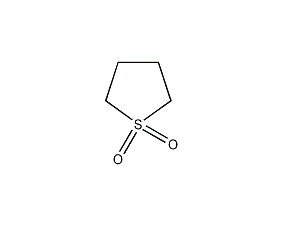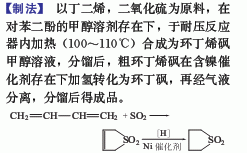
Structural formula
| Business number | 03K2 |
|---|---|
| Molecular formula | C4H8O2S |
| Molecular weight | 120.17 |
| label |
Tetrahydrothiophene 1,1-dioxide, Tetramethylene sulfone, plasticizer, Aromatic hydrocarbon extraction agent, Acid gas remover, Additives for acrylic fiber spinning |
Numbering system
CAS number:126-33-0
MDL number:MFCD00005484
EINECS number:204-783-1
RTECS number:XN0700000
BRN number:107765
PubChem number:24889157
Physical property data
1. Properties: colorless and transparent liquid.
2. Boiling point (ºC, 101.3kPa): 287.3
3. Melting point (ºC): 28.45
4. Relative density (g/mL, 30 /4ºC): 1.2614
5. Relative vapor density (g/mL, air=1): 4.2
6. Refractive index (30ºC): 1.4820
7. Viscosity (mPa·s, 30ºC): 10.286
8. Flash point (ºC): 166
9. Heat of vaporization (KJ/mol, 100ºC): 62.8
10. Heat of fusion (KJ/mol): 1.42
11. Heat of combustion (KJ/kg): 11.42
12. Specific heat capacity (KJ/(kg ·K), 30ºC, constant pressure): 1.50
13. Conductivity (S/m, 30ºC): <2×10-8
14. Vapor pressure (kPa, 150ºC): 1.93
15. Vapor pressure (kPa, 118ºC): 0.67
16. Solubility: Miscible with almost all organic solvents. In addition to aliphatic hydrocarbons, it can dissolve most organic compounds. It can also dissolve inorganic salts and polymer compounds.
Toxicological data
1. Skin/eye irritation data: rabbit eye contact: mild reaction at 253mg
2. Acute toxicity data: rat oral LD50: 1540 uL/kg; rat inhalation LC: >250 mg/m3/8h;
Rat skin LD50:> 3800 mg/kg; rats LD50: 1600 mg/kg;
Rat subcutaneous LD50: 1620 ul/kg ;Mouse oral LD50: 1900 mg/kg;
bsp; Mouse abdominal LD50: 1250 mg/kg; Mouse intravenous LD50: 1080 mg/kg;
Rabbit skin LD50: 3180 uL/kg
3. Other multiple dose data : Rat Outlet TDLO: 6750 mg/kg/2W-i; Dog Morizer TDLO: 6350 mg/kg/23W-i
Spiritive animals-Monkey inhale TCLO: 495 mg/m3/m3/m3/m3/m3/m3/m3/m3/m3/m3/m3/m3/m3/m3/m3 8H/27D-I
Ecological data
General remarks
Water hazard level 1 (German regulations) (self-assessment through list) This substance is slightly hazardous to water.
Do not allow undiluted or large amounts of product to come into contact with groundwater, waterways or sewage systems.
Do not discharge materials into the surrounding environment without government permission.
Molecular structure data
1. Molar refractive index: 27.33
2. Molar volume (cm3/mol): 95.2
3. Isotonic specific volume (90.2K ): 232.7
4. Surface tension (dyne/cm): 35.6
5. Polarizability (10-24cm3): 10.83
Compute chemical data
1. Reference value for hydrophobic parameter calculation (XlogP): None
2. Number of hydrogen bond donors: 0
3. Number of hydrogen bond acceptors: 2
4. Number of rotatable chemical bonds: 0
5. Number of tautomers: none
6. Topological molecule polar surface area 42.5
7. Number of heavy atoms: 7
8. Surface charge: 0
9. Complexity: 128
10. Number of isotope atoms: 0
11. Determine the number of atomic stereocenters: 0
12. Uncertain number of atomic stereocenters: 0
13. Determine the number of chemical bond stereocenters: 0
14. Number of uncertain chemical bond stereocenters: 0
15. Number of covalent bond units: 1
Properties and stability
Chemical properties: Good thermal stability. When heated to above 220°C for 5 hours, only 2% decomposes to form sulfur dioxide. It is stable to acids and alkalis and does not decompose when heated to near the boiling point. Can react with chlorine. Can form complexes with cobalt and boron compounds.
This product has low toxicity. Generally, the oral LD for animals is 500.73~9.4g/kg. If it splashes on skin, rinse with water.
Storage method
Packed in galvanized iron drums and stored at room temperature or low temperature. Store and transport according to general chemical regulations.
Synthesis method
Refining method: Add granular sodium hydroxide to sulfolane for distillation, or use a distillation tower with a column height of 1.5m and equipped with glass packing for vacuum distillation.

Purpose
Due to its high thermal stability and stability to acids and alkalis, it is an excellent solvent. It can be used to extract aromatic hydrocarbons from aliphatic hydrocarbons and remove acid gases from gas mixtures. Sulfolane can be used as a solvent for polymer compounds such as polyacrylonitrile, acrylonitrile copolymer, polyvinyl fluoride, etc., for spinning, making films, etc. It can also be used as a plasticizer for cellulose ether, polyvinyl alcohol, polyethylene, polyvinyl chloride, polyamide, etc., and an additive for acrylic fiber spinning. Others can also be used for the separation of fatty acids and the extraction of non-cellulosic components from wood. Because sulfolane has a high boiling point, good thermal stability, and non-corrosive properties, it can be used as a condenser carrier. Adding to press oil can improve corrosion resistance, flame retardancy, thermal stability, viscosity and other properties.


